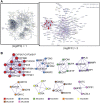Exploring the mechanisms underlying the therapeutic effect of the Radix Bupleuri-Rhizoma Cyperi herb pair on hepatocellular carcinoma using multilevel data integration and molecular docking
- PMID: 36403263
- PMCID: PMC9740357
- DOI: 10.18632/aging.204388
Exploring the mechanisms underlying the therapeutic effect of the Radix Bupleuri-Rhizoma Cyperi herb pair on hepatocellular carcinoma using multilevel data integration and molecular docking
Abstract
Traditional Chinese medicine (TCM) is a promising and effective treatment for cancer with minimal side effects through a multi-active ingredient multitarget network. Radix Bupleuri and Rhizoma Cyperi are listed as herbs dispersing stagnated liver Qi in China. They have been used clinically to treat liver diseases for many years and recent pharmacological studies have shown that they inhibit the proliferation of hepatocellular carcinoma (HCC). However, the pharmacological mechanisms, potential targets, and clinical value of the Radix Bupleuri-Rhizoma Cyperi herb pair (CXP) for suppressing HCC growth have not been fully elucidated. We identified 44 CXP targets involved in the treatment of HCC using the GEO dataset and HERB database. An analysis of the Traditional Chinese Medicine System Pharmacology Database (TCMSP) showed that CXP exerts synergistic effects through 4 active ingredients, including quercetin, stigmasterol, isorhamnetin, and kaempferol. GO and KEGG analyses revealed that CXP mainly regulates HCC progression through metabolic pathways, the p53 signaling pathway, and the cell cycle. Additionally, we applied The Cancer Genome Atlas (TCGA)-liver hepatocellular carcinoma (LIHC) database to perform the expression patterns, clinical features, and prognosis of 6 genes (CCNB1, CDK1, CDK4, MYC, CDKN2A, and CHEK1) in cell cycle pathways to reveal that CXP suppresses HCC clinical therapeutic value. Moreover, based on molecular docking, we further verified that CXP exerts its anti-HCC activity through the interaction of multiple active components with cell cycle-related genes. We systematically revealed the potential pharmacological mechanisms and targets of CXP in HCC using multilevel data integration and molecular docking strategies.
Keywords: Radix Bupleuri-Rhizoma cyperi herb pair (CXP); cell cycle; hepatocellular carcinoma (HCC); molecular docking; traditional chinese medicine (TCM).
Conflict of interest statement
Figures










Similar articles
-
Multilevel data integration and molecular docking approach to systematically elucidate the underlying pharmacological mechanisms of Er-Zhi-Wan against hepatocellular carcinoma.Aging (Albany NY). 2022 Nov 7;14(21):8783-8804. doi: 10.18632/aging.204369. Epub 2022 Nov 7. Aging (Albany NY). 2022. PMID: 36347033 Free PMC article.
-
A Strategy based on Bioinformatics and Machine Learning Algorithms Reveals Potential Mechanisms of Shelian Capsule against Hepatocellular Carcinoma.Curr Pharm Des. 2024;30(5):377-405. doi: 10.2174/0113816128284465240108071554. Curr Pharm Des. 2024. PMID: 38310567
-
Astragali radix - Curcumae rhizoma herb pair suppresses hepatocellular carcinoma through EGFR/AKT/mTOR pathway and induces lipid peroxidation-related ferroptosis via HIF-1α/HO-1/GPX4 axis.J Ethnopharmacol. 2025 May 28;348:119912. doi: 10.1016/j.jep.2025.119912. Epub 2025 Apr 30. J Ethnopharmacol. 2025. PMID: 40316156
-
Network pharmacology and molecular docking technology for exploring the effect and mechanism of Radix Bupleuri and Radix Paeoniae Alba herb-pair on anti-hepatitis: A review.Medicine (Baltimore). 2023 Dec 1;102(48):e35443. doi: 10.1097/MD.0000000000035443. Medicine (Baltimore). 2023. PMID: 38050220 Free PMC article. Review.
-
Anti-anger Effects of Herbal Medicine: A Mini-Review of Rat Studies.Chin J Integr Med. 2022 Mar;28(3):263-271. doi: 10.1007/s11655-022-3506-3. Epub 2022 Jan 27. Chin J Integr Med. 2022. PMID: 35084699 Review.
Cited by
-
Stigmasterol Attenuates Triple-negative Breast Cancer Stem Cell Properties by Inhibiting JAK3.J Cancer. 2025 Feb 3;16(5):1618-1630. doi: 10.7150/jca.94822. eCollection 2025. J Cancer. 2025. PMID: 39991585 Free PMC article.
-
Anhydroicaritin suppresses tumor progression via the PI3K/AKT signaling pathway in hepatocellular carcinoma.Aging (Albany NY). 2023 Aug 8;15(15):7831-7843. doi: 10.18632/aging.204948. Epub 2023 Aug 8. Aging (Albany NY). 2023. PMID: 37556351 Free PMC article.
References
-
- Fitzmaurice C, Abate D, Abbasi N, Abbastabar H, Abd-Allah F, Abdel-Rahman O, Abdelalim A, Abdoli A, Abdollahpour I, Abdulle ASM, Abebe ND, Abraha HN, Abu-Raddad LJ, et al., and Global Burden of Disease Cancer Collaboration. Global, Regional, and National Cancer Incidence, Mortality, Years of Life Lost, Years Lived With Disability, and Disability-Adjusted Life-Years for 29 Cancer Groups, 1990 to 2017: A Systematic Analysis for the Global Burden of Disease Study. JAMA Oncol. 2019; 5:1749–68. 10.1001/jamaoncol.2019.2996 - DOI - PMC - PubMed
MeSH terms
Substances
LinkOut - more resources
Full Text Sources
Medical
Research Materials
Miscellaneous

